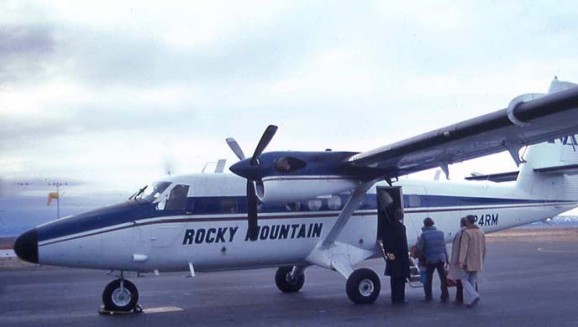Miracle on Buffalo Pass will be released worldwide on September 23, 2017. The book documents the events of Rocky Mountain Airways Flight 217 on December 4, 1978 and I’m happy to share a brief excerpt from the opening chapter. Click on the photo page to view more photos from the book.
Flight 216 was late. Not an unusual turn of events for the winter of 1978 in Colorado. The departure from Denver had been delayed, and now strong headwinds were restricting the progress to Steamboat Springs. Captain Scott Klopfenstein and First Officer Gary Coleman prepared for the descent and approach and waited to clear the mountains east of Steamboat. The mountain range was not only an obstacle to navigation—it was also significant for several other reasons. On the west side of the range, the famous Steamboat Ski Resort could be found, and that would eventually be the destination for most of the passengers aboard Flight 216. The east side of the range constituted the Routt National Forest and nothing but wilderness. The ridge line at the top of the range not only divided ski slopes from wilderness, it also divided the United States of America. The squiggly line on a map represented the Continental Divide.
The aircraft’s distance measuring equipment (DME) was not operating to give the pilots a mileage readout to Steamboat making it necessary for them to cross reference two navigation stations to calculate when they would be beyond the mountain and it would be safe to descend. The DME was not required for the flight, but nonetheless very useful in that it would normally display an accurate mileage readout to any navigation station within 200 miles. The Denver Air Traffic Control Center did not provide radar service at the lower altitudes in the Steamboat area, although radio communications were usually good. Despite the strong headwinds and cloud cover, the flight was smooth with surprisingly little turbulence.
When Air Traffic Control cleared Flight 216 to descend, First Officer Coleman read the clearance back and glanced out the cockpit window to inspect the wing and propeller on the right side of the aircraft. Satisfied there was no ice accumulation, he continued to monitor the instruments and review the approach procedure for Steamboat Springs. The weather at the airport was reported as overcast at 2000 feet above the ground and six-miles visibility with light winds—well above the minimums for landing. The temperature hovered in the twenties, and snow was always a possibility in December, but none was reported now. Scott and Gary briefly discussed the familiar approach procedure and agreed the weather was not a problem.
With any luck, they would be able to turn the aircraft around quickly and head back to Denver to complete a long flying day. Both crewmembers had reported for duty at 12:30 in the afternoon, and now with sunset they protected their night vision by keeping the cockpit lights to a dim glow. The runway lights at Steamboat would be a welcome sight when they broke out of the clouds. Even with a quick turnaround, they would be fortunate to finish their duty day by 8:30. They had been forced to abort the first flight of the day and return to Denver because of the strong westerly headwinds. Every passenger seat would be occupied on the return flight and they would enjoy the advantage of a tailwind.
The passenger terminal at Steamboat Springs consisted of one large room with random seating for customers awaiting arriving and departing flights. Rocky Mountain Airways Flight 217 was scheduled to depart at 4:45 p.m. It was now after six, and the inbound flight was nowhere in sight. Some of the paying customers were voicing their frustration and expressing their displeasure with the airline. Others were accustomed to Colorado weather and the disruption it often caused for most activities—including airline flights. Whether they waited patiently or otherwise—the terminal was their temporary crucible. They were a diverse group.
A young mother cared for her eight-month old son—and waited.
Three young ladies, who worked for the Forest Service, talked about their upcoming training class in Denver—and waited.
A young couple, engaged to be married, discussed their wedding plans—and waited.
A twenty-year old man, on a business trip for his employer, was not intimidated by the challenge of delay—and waited.
A retired military officer was well versed in schedules gone awry—and waited.
A nineteen-year old guy from Lakewood, near Denver, was returning home—and waited.
They all waited with one thing in common—the desire to get to Denver and points beyond—a final destination and an end to the waiting.
The announcement that Flight 216 was arriving was met with relief and anticipation. Passengers near the terminal’s window could see the aircraft’s landing lights in the distance. Those who chose not to watch the approach soon heard the sound of the turbo-prop engines, first as they were reversed to slow the airplane on the runway, and then again as they idled toward the terminal.

Photo courtesy of Dennis Heap




Leave a comment